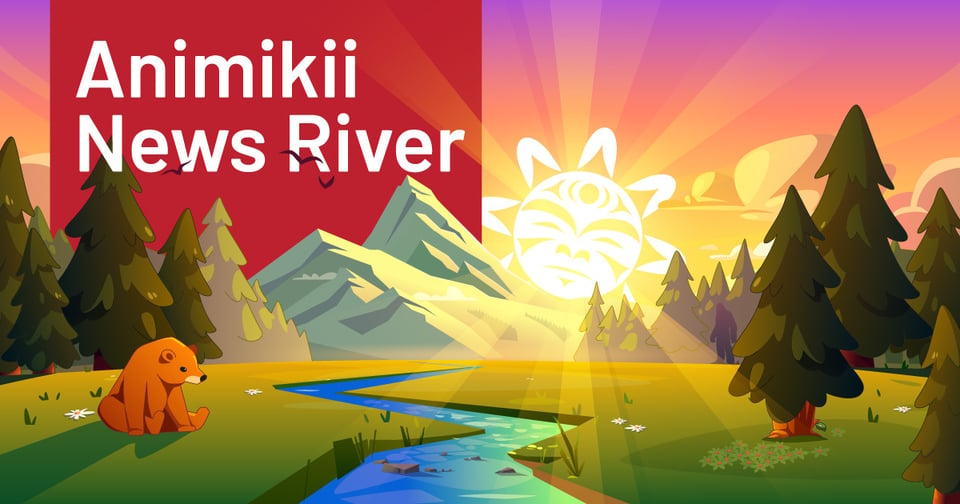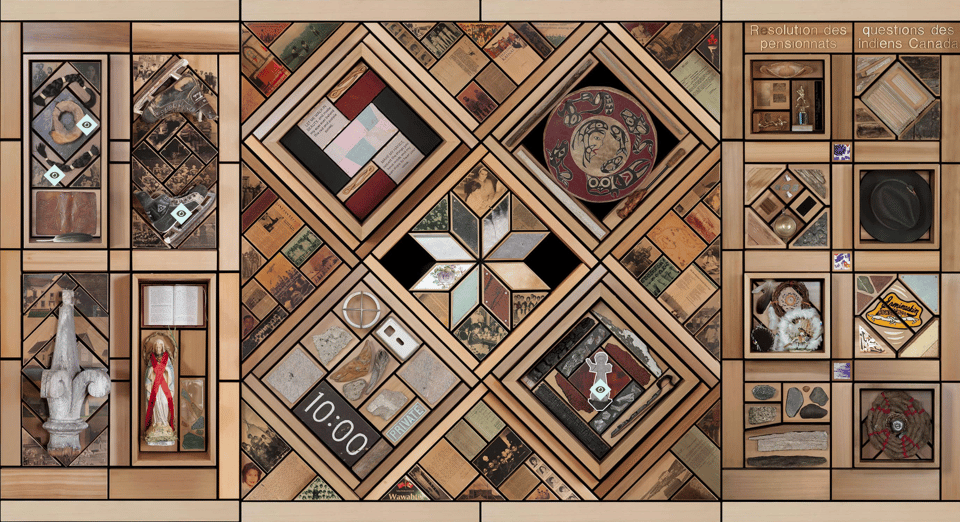When every object tells a story - we are witness to Truth
Exploring art as resistance, objects and stories as data, and upcoming NDTR

Boozhoo News River Readers,
We are less than a week away from the federal statutory holiday known as National Day for Truth and Reconciliation (NDTR). It’s a public acknowledgement that the ongoing impacts faced by Indigenous peoples are rooted in the colonial actions of the nation now called Canada.
NDTR commemorates and honours the children who died while attending residential schools and the survivors, families and communities still affected by the legacy of the residential school system.
Across the country in the coming days, you can find local activities and gatherings organized to remind us that Every Child Matters. What’s even more awesome? Orange Shirt Day started as an Indigenous-led awareness campaign about intergenerational impacts through the loss of culture, freedom, and self-esteem that many Indigenous children experienced.
Find an event and share space with a community near you, self reflect with the help of a new book, chat with close family and friends, wear orange.
As always, we thank you for being here.
This week’s stories include:
Canada Learning Code merges with Ampere to expand digital literacy for all
Recognising Indigenous data sovereignty and implementing Indigenous data governance
GIDA: CARE Directs Us Home: Prioritizing Indigenous Peoples’ Community Standards

When every object tells a story - we are witness to Truth
The big picture: Inspired by a woven blanket, The Witness Blanket is a large-scale work of art created by Carey Newman. It was created to encourage people to learn more about the ongoing impacts of residential schools. The artwork, and the interactive website built to share it, contains hundreds of items reclaimed from residential schools, churches, government buildings and traditional and cultural structures from across Canada.
Why it matters: Through a unique digital experience you can explore the items and stories carried by the Witness Blanket. They are accompanied by the voices of Survivors who talk about the experience of being forced into residential schools. Their generous and insightful stories convey the reality of anti-Indigenous racism, colonialism and genocide. They reveal the ongoing harms caused by Canada’s residential school system.
Key points:
It is curated by the Canadian Museum for Human Rights and stands as a national monument, with every object donated to the Witness Blanket rooted to a place and a story.
These stories address themes of racism and cruelty. A “Safe space” is always available in the main navigation menu - to click away if you need to take a break or leave the page.
View the Broken Angel, learn about the object and where it came from, then hear the stories of Survivors through text and video.
What they’re saying: “My role as an artist is to bear witness. The pieces themselves are witnesses. The people giving us the pieces are witnesses, and, at some level, we are all – or we all should be – witnesses.” Carey Newman / Hayalthkin’geme, Artist
Learn more: View and interact with The Witness Blanket. Read more about the collaborative effort to build the site in this case study.
Curated Articles:
Strengthening trust: Dalhousie’s Indigenous research facilitator connects communities
Zane Sylliboy says his work as an Indigenous research facilitator is about linking two worlds. The role within the Office of the Vice President Research and Innovation was created to support researchers, both Indigenous and non-Indigenous, who want to work with Indigenous communities, and to strengthen how those relationships are built.Sylliboy says much of his work is focused on providing direction at the earliest stages of a project. His guidance includes reviewing existing plans and trying to help steer them toward better outcomes, noting that it’s important for researchers to understand from the beginning how they intend to acknowledge perspectives or interpretations that draw on traditional knowledge and Indigenous Ways of Knowing. A cornerstone of this effort is Dalhousie’s Mawkwil~mn~j: Let’s look for it together seed fund, which provides support for communities to shape projects with researchers. Sylliboy says the program, currently accepting applications for its November 30 deadline, is meant to spark relationships and ensure that research questions start with community priorities.
The concepts of Indigenous data sovereignty and Indigenous data governance have attracted a great deal of attention over the last two decades. There have been several international symposia and roundtable discussions on the subject and a larger number of books and articles have been published. This paper focuses on developments in Australia, New Zealand, Canada and the United States of America, as countries with similar historical experiences, particularly in the relationship between the non-Indigenous colonisers and local Indigenous populations. This paper discusses development of theoretical positions on Indigenous data sovereignty and the mechanism by which this can be achieved, namely: Indigenous data governance. The variety of models, frameworks and principles are then examined. It also describes current projects being undertaken to assist Indigenous communities exercise sovereignty over their data and provides some examples of what can be achieved when research privileges an Indigenous world view and focuses on issues important to Indigenous people and communities.
GIDA: CARE Directs Us Home: Prioritizing Indigenous Peoples’ Community Standards
FNIGC, along with members of the Global Indigenous Data Alliance (GIDA), is pleased to share the latest communique titled: CARE Directs Us Home: Prioritizing Indigenous Peoples’ Community Standards. Reflecting on the six years of the CARE Principles (Collective Benefit, Authority to Control, Responsibility, Ethics) for Indigenous Data Governance, this joint communiqué from GIDA members emphasizes that standards are more than technical tools. GIDA calls on institutions, researchers, and standards bodies to uphold and prioritize the standards set by Indigenous Peoples and communities when working with Indigenous data. Honouring Indigenous community standards plays a key role in advancing Indigenous Data Sovereignty (IDSov) and Indigenous Data Governance (IDGov). These standards are rooted in the specific knowledge systems, rights, and cultural frameworks of each community. By following locally developed principles and protocols, data practices and the technologies that enable them are more likely to reflect Indigenous values, protect inherent rights, and contribute to self-determined futures.
Canada Learning Code merges with Ampere to expand digital literacy for all
Two of Canada’s leading non-profits, Canada Learning Code and Ampere (formerly the Pinnguaq Association), are joining forces to expand opportunities for people of all ages to thrive in today’s digital world. Through this merger, the two organizations bring together their shared strengths in democratizing access to technology, delivering hands-on learning, and co-designing with communities to ensure that digital literacy is accessible for everyone. Ampere, a non-profit that works alongside rural, remote, and Indigenous communities, is known for activating opportunities that strengthen and cultivate valuable STEAM (science, technology, engineering, arts, and math) skills. While Canada Learning Code (CLC), Canada’s leading national charity championing digital literacy education, delivers tech training and career development programs for people who are underrepresented in technology — with a strong emphasis on gender equity, newcomers, and Indigenous and racialized communities. Together the organizations will be a driving force in championing STEAM learning, access to technology, and innovative pathways to careers.
Professor creates 'a safe harbor' for Indigenous data
Repository to change who benefits from biomedical data, who decides how it’s used. Among Indigenous populations in the U.S., there is a history of personal data being used without consent. Now, a new digital repository hopes to change both who benefits from biomedical data and who gets to decide how it’s used. The Data for Indigenous Implementations Interventions and Innovation, or D4I, Tribal Data Repository is led by Arizona State University Assistant Professor Krystal Tsosie. The project centers Indigenous data and digital sovereignty from the ground up, technically and ethically. At its core, the repository is designed as a protected home for federally funded biomedical data originating with U.S. tribal nations and Indigenous peoples. Instead of a single gatekeeping key that unlocks everything, the system emphasizes federated and decentralized access models, and is built to incorporate modern tooling, including machine learning and AI. Tsosie, who is also the co-founder of the Native BioData Consortium, calls it “a safe harbor” that adheres to tribal laws and policies.
High Commissioner Türk: Let’s define human rights for the digital age
We gather at a moment that is widely agreed to be a turning point for our relationships with technology, with work, with our political representatives, with each other, and with ourselves. The themes of this gathering – how we can align resources, strategy, and imagination to serve the public good – are clearly central to this moment. Because the choices we make today will play a part in shaping our societies, our economies, and ultimately our shared humanity, for generations to come. When I began my journey in human rights, the digital world was still emerging. I go back to cables and faxes, it was very different. Today, technology is no longer the backdrop to human rights. It is the front line. And all human rights have a digital dimension.

Add a comment: